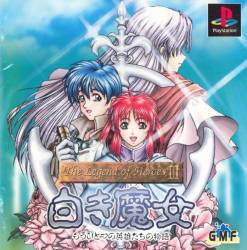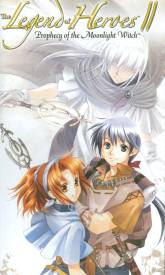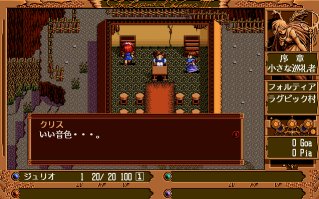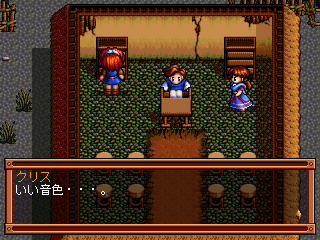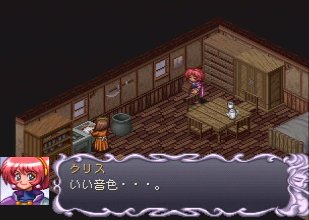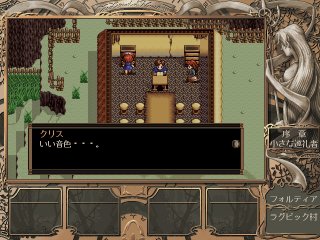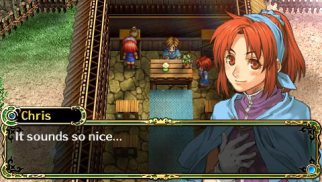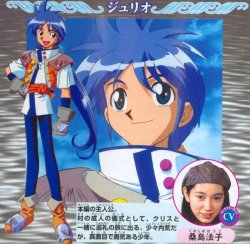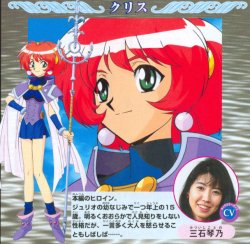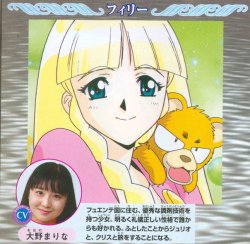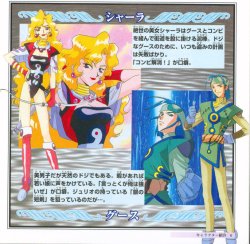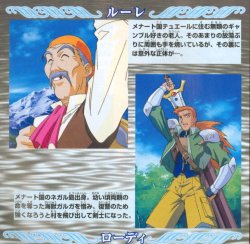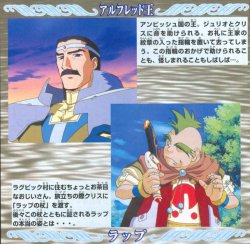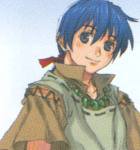
|
Jurio
|

|
Chris
|

|
Goose
|
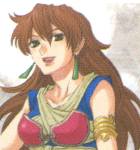
|
Shirla
|
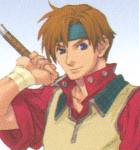
|
Lodi
|
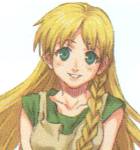
|
Filly
|
The storyline is pretty interesting at the beginning, as there's a certain romantic notion of two young kids adventuring into the world, their naivety slowing giving way to experience as they wander the world, meet its people, and help those in trouble. Jurio and Chris are a cute couple, who offer bicker like an old married couple, and there are plenty of nice touches, like the repeated stories of the legendary mariner Captain Thomas, whom many of the characters idolize. There's a lot of detail written into the game world, which is impressive for an RPG from 1994.
However, Legend of Heroes 3 is far more concentrated on telling a story than letting you role play, even more so than your typical Japanese RPG. Beyond the battles, there's very little that can be termed gameplay - you go from town to town, run into roadblocks, find the event trigger, continue, and repeat. There's very little variation in the scenery, and after several hours, the game feels like a slog. It doesn't help that the only English translation, the PSP version, is severely underwhelming, which ruins some of the intended charm of the original release.
The PC98 version of Legend of Heroes 3 features some rather nice, if repetitive graphics, and the movement is rather choppy. However, the soundtrack is excellent, as with most PC98 Falcom games. Enemy encounters occur at set points similar to Chrono Trigger, and the actual battles occur in real time. You can't directly control any of your characters, but can instead choose one of several "battle plans", which commands whether a character will attack, retreat, or use magic, based on how much HP they have. Then you let the AI take over and do its work. Both allies and enemies have "Vitality Points", which need to be balanced, lest you run out of energy. So the simple solution is simply to dodge until your enemies use up their VP, then attack. While it's nice that Falcom tried to do something different, it's more confusing than it need be.
The PSOne version, ported in 1997 (??) by a company called GMR, is pretty faithful to the original PC98 version. However, since the resolutions are completely different, GMR never bothered to redraw any of the graphics and simply zoomed in the perspective. Although the visuals are full screen, the characters are now huge, and you get a pretty small view of the landscape. Ultimately, it's a superficial difference, because the movement is much smoother than the PC version. The remixed music is also pretty decent. The original battle system was ditched and replaced with the Arc the Lad-style tactical system found in Legend of Heroes 4. However, you can still sit back and watch the AI duke it out for you.
Hudson and Falcom had a previous working relationship in bringing the Ys titles to the PC Engine, and they teamed up once again to bring Legend of Heroes 3 to the Saturn. Perhaps feeling the original game wouldn't appeal to the console audience, Hudson drastically reworked the game, keeping the storyline and characters but reimagining almost every other aspect. The characters have been completely redesigned with a brighter, anime-style aesthetic (complete with animated cutscenes), and there's a ton of voice acting. The graphics have been entirely redone to feature a 3/4 skewed view instead of the overhead perspective of the original. The "sit back and watch" battle system has been replaced by a standard turn-based RPG battle system, which does a long ways to making the game more involving. Like the original, there aren't any random battles, so the game moves at a brisk page. While it's easy to view some of these changes as "dumbing down" for a different market, it's an interesting take on the game.
In 1999, Falcom brought Legend of Heroes 3 to Windows-based computers, which is sometimes referred to as "Shin Eiyuu Densestsu 3". It's based off the PC98 version, offering slightly improved SVGA graphics, although they still look pretty outdated. There are some new story segments, including a slightly expanded intro. The battle system is pretty similar to the original version, although this time you can actually issue direct orders to your characters, telling them who to fight and what special moves to use, the same system which is used in the Windows version of the rest of the Garghav Trilogy. The music has also been remixed again.
In 2003, Bandai ported all three games in the Garghav Trilogy to the PSP. Legend of Heroes 3 was a launch title in Japan, although it wasn't released in America until 2006. All of the backgrounds have been rendered in 3D, using sprites similar to the Windows versions, and featuring gorgeous portraits for the main characters. Important NPCs are also highlighted with a red exclamation point, so it's easier to find who to talk to in order to get the plot progressing. In spite of these changes, most of the maps remain the same. Fights are no longer predetermined, but instead you can enter combat by running into foes. The battle system is pretty similar to PC98 version, although you can choose when to use magic and special attack, making it more involving than the original but less than the Windows remake. Since it was a launch game, the Japanese released by plagued by some annoying load times. However, this version probably has the best music, as they're taken from various arranged symphonic CDs, as well as a few exclusive high quality arrangements. The battle music is also completely different.
Namco Bandai actually fixed some of these issues in the American release, which reduced most of the load times, and used the battle system found in the PSP version Legend of Heroes: Tear of Vermillion. Perhaps they felt that the limited interaction of the original battle system wouldn't have gone over well with Americans (and they'd probably be right.) There are some other weird changes too - in the Japanese version, your pet only existed to pick up the occasional bonus item. In the American version, it will actually execute preemptive attacks in certain battles, based on what you feed it. The types of attacks are determined by the pet food you give to it. Again, this was another system brought over from Legend of Heroes: Tear of Vermillion. Also changed is how your party gains new spells - in the Japanese version, you visit various chapels in found throughout different towns. In the American version, the chapels only exist to sell pet food (??), and you get new skills by leveling up.
Alas, as mentioned above, the localization is incredibly subpar. It seems like they just got someone to literally translate the text, without rewriting any of it for English. As a result, dialogue that should be funny just feels emotionless. There's one character, Alfred, whom characters refer to as "talking in an odd manner", but doesn't seem to speak any differently than anyone else. If this title had been localized by Working Designs (god rest their soul) or Atlus, it probably would've come out much better, especially in a title that's so dependent on its likable characters. Regardless, the game was met with apathy by critics, mostly because the game feels so outdated - which is true, but it's still a classic in its own right.
MP3s


